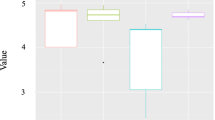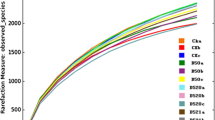Abstract
Plants interact with a myriad of microbial cells in the rhizosphere, an environment that is considered to be important for plant development. However, the differential structuring of rhizosphere microbial communities due to plant cultivation under differential agricultural practices remains to be described for most plant species. Here we describe the rhizosphere microbiome of grapevine cultivated under conventional and organic practices, using a combination of cultivation-independent approaches. The quantification of bacterial 16S rRNA and nifH genes, by quantitative PCR (qPCR), revealed similar amounts of these genes in the rhizosphere in both vineyards. PCR-DGGE was used to detect differences in the structure of bacterial communities, including both the complete whole communities and specific fractions, such as Alphaproteobacteria, Betaproteobacteria, Actinobacteria, and those harboring the nitrogen-fixing related gene nifH. When analyzed by a multivariate approach (redundancy analysis), the shifts observed in the bacterial communities were poorly explained by variations in the physical and chemical characteristics of the rhizosphere. These approaches were complemented by high-throughput sequencing (67,830 sequences) based on the V6 region of the 16S rRNA gene, identifying the major bacterial groups present in the rhizosphere of grapevines: Proteobacteria, Actinobacteria, Firmicutes, Bacteriodetes, Acidobacteria, Cloroflexi, Verrucomicrobia and Planctomycetes, which occur in distinct proportions in the rhizosphere from each vineyard. The differences might be related to the selection of plant metabolism upon distinct reservoirs of microbial cells found in each vineyard. The results fill a gap in the knowledge of the rhizosphere of grapevines and also show distinctions in these bacterial communities due to agricultural practices.



Similar content being viewed by others
References
Abraham E, del Valle HF, Roig F et al (2009) Overview of the geography of the Monte Desert biome (Argentina). J Arid Environ 73:144–153. doi:10.1016/j.jaridenv.2008.09.028
Andreote FD, Azevedo JL, Araújo WL (2009a) Assessing the diversity of bacterial communities associated with plants. Braz J Microbiol 40:417–432
Andreote FD, Rossetto PB, Mendes R et al (2009b) Bacterial community in the rhizosphere and rhizoplane of wild type and transgenic eucalyptus. World J Microbiol Biotechnol 25:1065–1073. doi:10.1007/s11274-009-9990-9
Andreote FA, Da Rocha UN, Azevedo JL, van Overbeek LS (2010) Effect of bacterial inoculation, plant genotype and developmental stage on root-associated and endophytic bacterial communities in potato (Solanum tuberosum). Antonie Van Leeuwenhoek 97:389–399. doi:10.1007/s10482-010-9421-9
Aranda S, Montes-Borrego M, Jiménez-Díaz RM, Landa BB (2011) Microbial communities associated with the root system of wild olives (Olea europaea L. subsp. europaea var. sylvestris) are good reservoirs of bacteria with antagonistic potential against Verticillium dahliae. Plant Soil 343:329–345. doi:10.1007/s11104-011-0721-2
Bertrand H, Nalin R (2001) Isolation and identification of the most efficient plant growth-promoting bacteria associated with canola (Brassica napus). Biol Fertil Soils 33:152–156
Bisigato A, Villagra P, Ares J, Rossi B (2009) Vegetation heterogeneity in Monte Desert ecosystems: a multi-scale approach linking patterns and processes. J Arid Environ 73:182–191
Boix-Fayos C, Calvo-Cases A, Imeson AC, Soriano-Soto MD (2001) Influence of soil properties on the aggregation of some Mediterranean soils and the use of aggregate size and stability as land degradation indicators. Catena 44:47–67. doi:10.1016/S0341-8162(00)00176-4
Bossio DA, Scow KM, Gunapala N, Graham KJ (1998) Determinants of soil microbial communities: effects of agricultural management, season, and soil type on phospholipid fatty acid profiles. Microb Ecol 36:1–12
Bronick CJ, Lal R (2005) Soil structure and management: a review. Geoderma 124:3–22. doi:10.1016/j.geoderma.2004.03.005
Caporaso JG, Kuczynski J, Stombaugh J et al (2010) Correspondence QIIME allows analysis of high-throughput community sequencing data Intensity normalization improves color calling in solid sequencing. Nat Publ Gr 7:335–336. doi:10.1038/nmeth0510-335
Caravaca F, Alguacil MM, Torres P, Roldán A (2005) Plant type mediates rhizospheric microbial activities and soil aggregation in a semiarid Mediterranean salt marsh. Geoderma 124:375–382. doi:10.1016/j.geoderma.2004.05.010
Clarke KR, Gorley RN (2006) Primer v6: user manual/tutorial. PRIMER-E, Plymouth
De Fina AL (1992) Aptitud agroclimática de la República Argentina. First edition. Academia Nacional de Agronomía y Veterinaria [ed.]. Buenos Aires
Dell’Amico E, Mazzocchi M, Cavalca L et al (2008) Assessment of bacterial community structure in a long-term copper-polluted ex-vineyard soil. Microbiol Res 163:671–683. doi:10.1016/j.micres.2006.09.003
Dias ACF, Pereira e Silva MDC, Cotta SR et al (2012) Abundance and genetic diversity of nifH gene sequences in anthropogenically affected Brazilian mangrove sediments. Appl Environ Microbiol 78:7960–7967. doi:10.1128/AEM.02273-12
Dias ACF, Dini-Andreote F, Hannula SE et al (2013) Different selective effects on rhizosphere bacteria exerted by genetically modified versus conventional potato lines. PLoS One 8:e67948. doi:10.1371/journal.pone.0067948
Edgar RC (2010) Search and clustering orders of magnitude faster than BLAST. Bioinformatics 26:2460–2461
Farinelli F (2007) The awakening of the sleeping giant: export growth and technological catch-up of the Argentine wine industry. Int J Technol Glob 3:179–196
Girvan M, Bullimore J (2003) Soil type is the primary determinant of the composition of the total and active bacterial communities in arable soils. Appl Environ Microbiol 69:1800–1809. doi:10.1128/AEM.69.3.1800
Gomes N, Heuer H, Schönfeld J (2001) Bacterial diversity of the rhizosphere of maize (Zea mays) grown in tropical soil studied by temperature gradient gel electrophoresis. Plant Soil 232:167–180
Hammer O, Harper DAT, Ryan PD (2011) PAST—paleontological statistics: paleontological statistics software package for education and data analysis. Paleontol Electron 4:9
Hardoim PR, Andreote FD, Reinhold-Hurek B et al (2011) Rice root-associated bacteria: insights into community structures across 10 cultivars. FEMS Microbiol Ecol 77:154–164. doi:10.1111/j.1574-6941.2011.01092.x
Heuer H, Krsek M, Baker P et al (1997) Analysis of actinomycete communities by specific amplification of genes encoding 16S rRNA and gel-electrophoretic separation in denaturing gradients. Appl Environ Microbiol 63:3233–3241
INV (Instituto nacional de Vitivinicultura) (2011) Registro de viñedos y superficie. San Juan- Base datos congelada al cierre de la cosecha 2011
Lejon DPH, Martins JMF, Lévêque J et al (2008) Copper dynamics and impact on microbial communities in soils of variable organic status. Environ Sci Technol 42:2819–2825
Linsenmeier A, Lehnart R, Löhnertz O, Michel H (2010) Investigation of grapevine root distribution by in situ minirhizotron observation. Vitis 49:1–6
Mäder P, Fliessbach A, Dubois D et al (2002) Soil fertility and biodiversity in organic farming. Science 296:1694–1697. doi:10.1126/science.1071148
Martins G, Miot-Sertier C, Lauga B et al (2012) Grape berry bacterial microbiota: impact of the ripening process and the farming system. Int J Food Microbiol 158:93–100. doi:10.1016/j.ijfoodmicro.2012.06.013
Mendes R, Kruijt M, de Bruijn I et al (2011) Deciphering the rhizosphere microbiome for disease-suppressive bacteria. Science 332:1097–1100. doi:10.1126/science.1203980
Morlat R, Jacquet A (2003) Grapevine root system and soil characteristics in a vineyard maintained long-term with or without interrow sward. Am J Enol Vitc 54(1):1–7
Muyzer G, de Waal EC, Uitterlinden AG (1993) Profiling of complex microbial populations by denaturing gradient gel electrophoresis analysis of polymerase chain reaction-amplified genes coding for 16S rRNA. Appl Environ Microbiol 59:695–700
Philippot L, Raaijmakers JM, Lemanceau P, van der Putten WH (2013) Going back to the roots: the microbial ecology of the rhizosphere. Nat Rev Microbiol 11:789–799. doi:10.1038/nrmicro3109
Poly F, Monrozier LJ, Bally R (2001) Improvement in the RFLP procedure for studying the diversity of nifH genes in communities of nitrogen fixers in soil. Res Microbiol 152:95–103
Prosser JI, Nicol GW (2008) Relative contributions of archaea and bacteria to aerobic ammonia oxidation in the environment. Environ Microbiol 10:2931–2941. doi:10.1111/j.1462-2920.2008.01775.x
Puglisi E, Pascazio S, Suciu N et al (2013) Rhizosphere microbial diversity as influenced by humic substance amendments and chemical composition of rhizodeposits. J Geochem Explor 129:82–94. doi:10.1016/j.gexplo.2012.10.006
Saison C, Degrange V, Oliver R et al (2006) Alteration and resilience of the soil microbial community following compost amendment: effects of compost level and compost-borne microbial community. Environ Microbiol 8:247–257. doi:10.1111/j.1462-2920.2005.00892.x
Silva AP, Babujiaa LC, Matsumotoa LS et al (2013) Bacterial diversity under different tillage and crop rotation systems in an oxisol of southern Brazil. Open Agric J 7:40–47
Simonet P, Grosjean MC, Misra AK et al (1991) Frankia genus-specific characterization by polymerase chain reaction. Appl Environ Microbiol 57:3278–3286
Smalla K, Wieland G, Buchner A et al (2001) Bulk and rhizosphere soil bacterial communities studied by denaturing gradient gel electrophoresis: plant-dependent enrichment and seasonal shifts revealed. Appl Environ Microbiol 67:4742–4751. doi:10.1128/AEM.67.10.4742-4751.2001
Sogin ML, Morrison HG, Huber JA et al (2006) Microbial diversity in the deep sea and the underexplored “rare biosphere”. Proc Natl Acad Sci USA 103:12115–12120. doi:10.1073/pnas.0605127103
Steenwerth KL, Drenovsky RE, Lambert J-J et al (2008) Soil morphology, depth and grapevine root frequency influence microbial communities in a Pinot noir vineyard. Soil Biol Biochem 40:1330–1340. doi:10.1016/j.soilbio.2007.04.031
Ter Braak C, Smilauer P (1998) CANOCO reference manual and user’s guide to Canoco for Windows: software for canonical community ordination (version 4)
Van Elsas JD, Chiurazzi M, Mallon CA et al (2012) Microbial diversity determines the invasion of soil by a bacterial pathogen. Proc Natl Acad Sci USA 109:1159–1164. doi:10.1073/pnas.1109326109
Van Overbeek L, van Elsas JD (2008) Effects of plant genotype and growth stage on the structure of bacterial communities associated with potato (Solanum tuberosum L.). FEMS Microbiol Ecol 64:283–296. doi:10.1111/j.1574-6941.2008.00469.x
van Raij B, Andrade JC, Cantarella H, Quaggio JA (2001) Análise química para avaliação da fertilidade de solos tropicais. Instituto Agronômico, Campinas 1:173–277
Wu T, Chellemi DO, Graham JH et al (2008a) Comparison of soil bacterial communities under diverse agricultural land management and crop production practices. Microb Ecol 55:293–310. doi:10.1007/s00248-007-9276-4
Wu T, Chellemi DO, Graham JH, Rosskopf EN (2008b) Assessment of fungal communities in soil and tomato roots subjected to diverse land and crop management systems. Soil Biol Biochem 40:1967–1970. doi:10.1016/j.soilbio.2008.02.012
Zhang X, Norton L (2002) Effect of exchangeable Mg on saturated hydraulic conductivity, disaggregation and clay dispersion of disturbed soils. J Hydrol 260:194–205. doi:10.1016/S0022-1694(01)00612-6
Acknowledgments
The authors would like to thank the following company for assistance: “Las Moras” (Ing. Agr. Claudio Rodriguez) for rhizosphere samples. We also thank Rodrigo G. Taketani and Itamar S. Melo, from Embrapa Environment (Jaguariúna, Brazil), for their support of the sequencing methodology. This study was partially funded by Res. 022/13 CS. (SECyT and National University of San Juan, 2013–2014), and by a postdoctoral Grant awarded to A.D.V.A. from CONICET (2012/-2014).
Author information
Authors and Affiliations
Corresponding author
Electronic supplementary material
Below is the link to the electronic supplementary material.
Rights and permissions
About this article
Cite this article
Vega-Avila, A.D., Gumiere, T., Andrade, P.A.M. et al. Bacterial communities in the rhizosphere of Vitis vinifera L. cultivated under distinct agricultural practices in Argentina. Antonie van Leeuwenhoek 107, 575–588 (2015). https://doi.org/10.1007/s10482-014-0353-7
Received:
Accepted:
Published:
Issue Date:
DOI: https://doi.org/10.1007/s10482-014-0353-7




